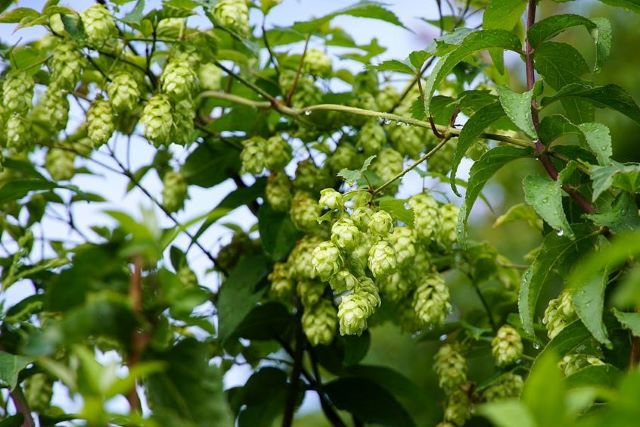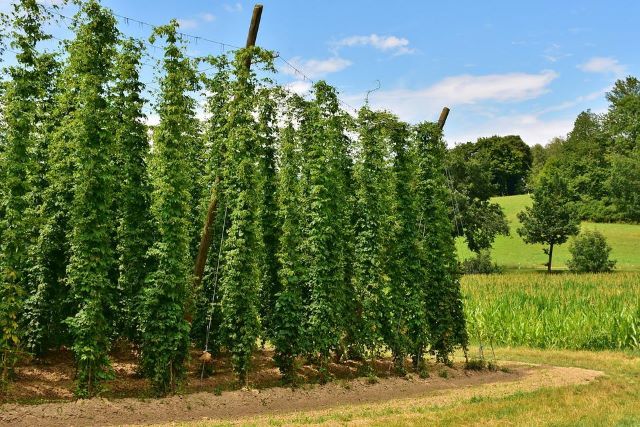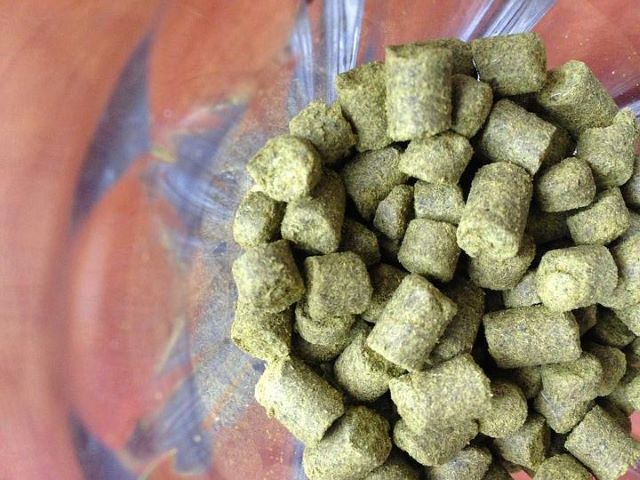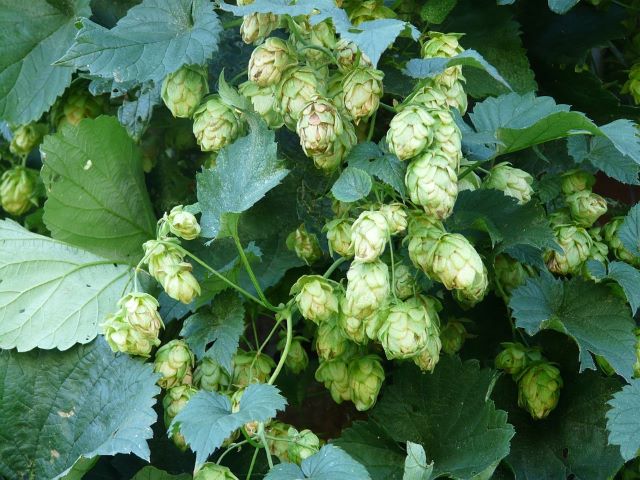We all know hops are somehow used to magically make beer, but did you know you can eat hops as well as use the hop plant beyond making beer? In this article, we’re exploring the topic of eating hops with recipes to try and other uses for hops. So read on, to find out more.

Table of Contents
What Are Hops Anyway?
Hops are the flower, often referred to as cone, of the climbing hop plant in the Cannabacea family, botanically known as Humulus lupulus. Hop plants climb like a vine but instead of a vine, it’s called a ‘bine’.
The plant is a perennial, meaning in the right conditions, a hop plant will continue to grow year after year. Generally, hop plants die back in the cold and shoot up again in spring.
For the purpose of eating hops, you want the female flowers. And because hop plants grow male and female plants, it’s best to grow the plant from the rhizome rather than seed to guarantee a female plant. As they grow, hop bines are trained along a support in the form of strong wire or twine.
Today hops are most known for flavoring and stabilizing beer, though they have been used for many years as herbal medicine.

Can you Eat Hops?
While the hops flower is most commonly known for the purpose of making beer, the entire hops plant is edible. That includes the flower as well as the hops leaves and shoots.
And even if you don’t love the taste of beer, hops still offer many delicious flavor profiles you can use for your culinary adventures.
The Taste of Hops
The taste of hops can definitely be described as bitter but there are many subtle underlying flavors that also describe hops. The bitterness is a result of the acid while the aroma of hops is a result of the essential oils.
The essential oils can depend on the variety of hop but include citrus, grass, earth, pine, spice, floral and fruity.
Both the acid and the essential oils are produced in the hop flower. They look like a yellow sticky secretion called lupulin. It’s a bit like pollen.
Quick Explanation of Hops Acids
Generally, acid hops are broken down into two categories; alpha acids and also beta acids.
The majority of bittering comes from the alpha acids. When making beer, this acid is extracted during the first boil over a longer time. The majority of the beta acids will evaporate during this time, which means there will be little or no aroma or flavor. To retain the hop flavor and aroma, hops are added to beer halfway through the boil or even after the boil has finished.
When purchasing hops, the acid profile is listed as a percentage, so you can choose the result your after. Hops are often categorized as “bittering” hops or “aroma” hops.
For eating hops, it’s preferable to choose an aroma hop and check it’s rated as low alpha acids. A high alpha acid maybe 19% whereas low alpha acid hops may only be 5%.
A good example would be the hop variety, Cascade. Cascade is often used for flavor and it has a low alpha acid level. Whereas a hop variety such as Centennial or Galaxy is often used for its bittering with a higher alpha acid level.
How To Cook With Hops
You will generally come across hops in three different forms: fresh hop flowers, dried hops (also known as leaf), and pellets.

For the purpose of cooking with hops, while you can use any form of hops, usually fresh hop flowers are best. So growing your own hops, or making friends with someone who does, is a great option for eating hops. Many beer brewers prefer pellets as they tend to be more consistent in bittering and flavor, which is important in beer brewing.
As mentioned earlier, you can eat the hop shoots and leaves as well as the flowers.
Choose the young, tender shoots for eating. You can harvest shoots throughout the season before the flowers appear but to opt for the younger shoots, you would usually harvest in the spring.
Young hop shoots can be cooked and eaten like asparagus. Try adding them to a frittata or pickling them.
Shoots can be sauteed, or steamed. Add some salt and butter and serve as a delicious side dish.
Hop flowers petals can be used to sprinkle on bruschetta or pizza.
You can turn hops into an extract that you can then use to flavor your cooking.
Make a delicious hot milk drink using dried hops flowers. And make your own hops salt with the dried cones.
Hops Storage Tips:
When using fresh hops, it’s a good idea to use them as soon as possible because they can deteriorate quickly. Hops degrade in light, air and heat.
So seal them up in a dark, air-tight container or storage bag and pop them in the refrigerator. They’ll store well for a few days. For longer-term storage, you can freeze hops.
Recipe Ideas Using Hops
Hopped-Up Bruschetta – from Bon Appetit. As well as the use of classic tomatoes, onions, garlic and olive oil, this twist on traditional brushetta uses fresh hop flowers.
Hops Salt Recipe – from Rebooted Mom. This very simple recipe for hops salt can then be used to flavor your dishes. Use either whole cone hops or pellets.
Spicy Pickled Hopshoots – from Limetree Roadside PubCafe. Pickling hop shots is a delicious way to eat them. This recipe calls for 16 cups of hop shoots. Pickled hop shoots are delicious with a cheese board, charcuterie or added to a salad.
Hop Shoot Frittata – from Forager Chef. Fresh hop shoots are combined with eggs and herbs for a yummy brunch dish.
Hoppy Tabbouleh – from Chef’s Table. The traditional use of herbs parsley and mint are given a flavor twist with the use of hops. This delicious salad can also be used as a sandwich or shawarma filling.
Hops Golden Milk – from Life’s Little Sweets. This recipe for hops golden milk uses some delicious spices including turmeric, cinnamon, ginger, cardamon and vanilla extract. The hero ingredient is of course hop flowers! These flowers are dried, so you can easily purchase them online.
Hop Flavored Beer Lollipops Recipe – from The Cooks Cook. Combining hop cones, butter, sugar, beer and sugar to make adult lollipops. These are a yummy sweet edible gift to make.
Other Uses for Hops

Hops have been used for their healing properties for many, many years. The hop flowers are said to have anti-inflammatory properties as well as calming and relaxing qualities to assist with sleep.
Medicinally, hops can be brewed into a tea, to aid sleep and provide those calming benefits.
These Hop Comb Flower Leaves are perfect for making tea!
Some other ideas for using hops include using hops in a floral arrangement. They’re very pretty and can easily contribute to a bouquet or be the star of their own show.
Make a herb pillow with dried hops and other flowers and herbs such as Valerian, lavender and dill. With their calming properties, this herb pillow can be kept under or near your sleeping pillow to promote sleep.
Hops can be used to make soap, lip balm, bath salts and hair products.
Some of My Favorite Kitchen Items:
Further reading:
- Kaffir Lime Fruit Uses In The Kitchen And Home
- Eating Nasturtium – Tips for Using Nasturtium In The Kitchen
- What Are Rose Hips And How To Eat Them
- Can You Eat Olives Off the Tree? Answered!
- Tomato Chili And Ginger Jam Recipe
- Growing Roses for Hips: Grow Guide for Edible Rose Hips
- Why Is My Garlic Bitter? Answered!
- Eating Yacon With Recipe Ideas
- Elderflower: What it Tastes Like and How To Use Them
